Vermont Castings SNV30 Instruction Manual
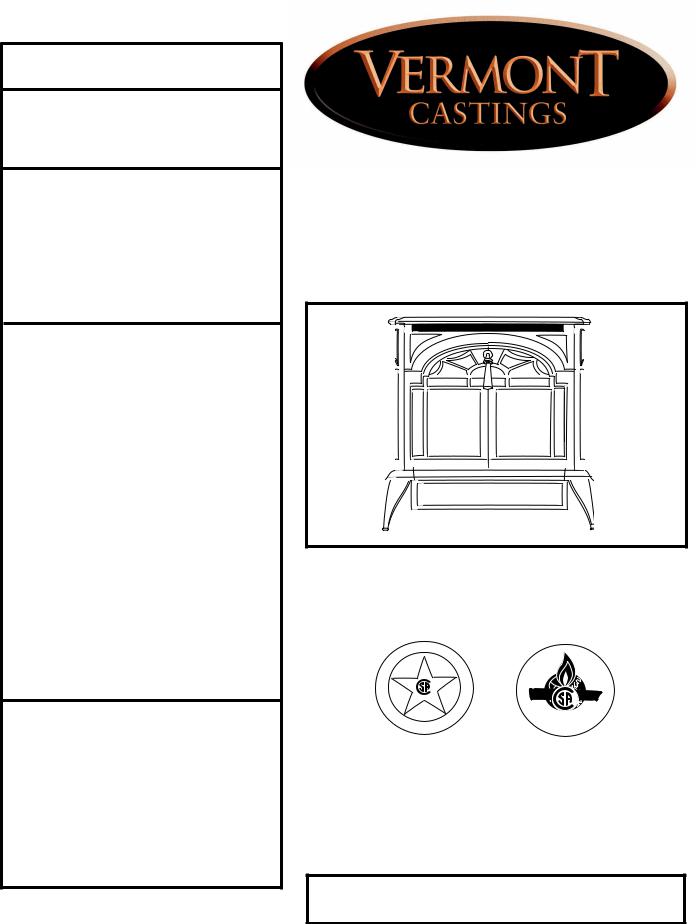
INSTALLER / CONSUMER SAFETY INFORMATION
PLEASE READ THIS MANUAL BEFORE INSTALLING AND USING APPLIANCE.
WARNING!
IF THE INFORMATION IN THIS MANUAL IS NOT FOLLOWED EXACTLY, A FIRE OR EXPLOSION MAY RESULT CAUSING PROPERTY DAMAGE, PERSONAL INJURY OR LOSS OF LIFE.
FOR YOUR SAFETY
Installation and service must be performed by a qualified installer, service agency or the gas suppler.
WHAT TO DO IF YOU SMELL
GAS:
•Do not try to light any appliance.
•Do not touch any electric switch; do not use any phone in your building.
•Immediately call your gas supplier from your neighbor’s phone. Follow the gas supplier’s instructions.
•If you cannot reach your gas supplier, call the fire department.
DO NOT STORE OR USE
GASOLINE OR OTHER FLAMMABLE VAPORS AND LIQUIDS IN THE VICINITY OF THIS OR ANY OTHER APPLIANCE.
This appliance may be installed in an after market permanently located manufactured (mobile) home where not prohibited by local codes.
This appliance is only for use with the type of gas indicated on the rating plate.
This appliance is not convertible for use with other gases unless a certified kit is used.
Stardance
Natural Vent Gas Heater
Model SNV30: 3980-3996
Homeowner’s Installation
and Operating Manual
|
|
|
|
|
|
CERTIFIED |
|
|
|
|
|
|
||
|
|
|
|
INSTALLER: Leave this manual with the appliance. CONSUMER: Retain this manual for future reference.
20007067 1/07 Rev. 8

Stardance Natural Vent Gas Heater
Table of Contents
PLEASE READ THE INSTALLATION & OPERATING INSTRUCTIONS BEFORE USING APPLIANCE. Thank you and congratulations on your purchase of a Vermont Castings stove.
IMPORTANT: Read all instructions and warnings carefully before starting installation. Failure to follow these instructions may result in a possible fire hazard and will void the warranty.
Installation & Operating Instructions ......................................................................................... |
3 |
Stove Dimensions ............................................................................................................... |
4 |
Clearance Requirements..................................................................................................... |
5 |
Alcove Minimum Dimensions .............................................................................................. |
5 |
Hearth Requirements .......................................................................................................... |
5 |
Gas Specifications............................................................................................................... |
6 |
Gas Inlet and Manifold Pressures ....................................................................................... |
6 |
High Elevations ................................................................................................................... |
6 |
Venting Requirements......................................................................................................... |
6 |
Vent Layout and Height Requirements................................................................................ |
6 |
Passing Through a Combustible Wall or Ceiling ................................................................. |
7 |
Venting Requirements......................................................................................................... |
7 |
Installation |
|
Unpack the Stove................................................................................................................ |
8 |
Install the Optional Fan ....................................................................................................... |
8 |
Venting System Assembly................................................................................................... |
9 |
Paint Option for Enamelled Stoves ................................................................................... |
10 |
Connect the Gas Supply Line............................................................................................ |
10 |
Burner Information............................................................................................................. |
11 |
Install ON/OFF Switch....................................................................................................... |
11 |
Thermostat Connection..................................................................................................... |
11 |
Install the Logset ............................................................................................................... |
11 |
Install the Front Plate ........................................................................................................ |
12 |
Operation |
|
Your First Fire.................................................................................................................... |
13 |
Pilot and Burner Inspection ............................................................................................... |
13 |
Flame & Temperature Adjustment..................................................................................... |
13 |
Flame Characteristics........................................................................................................ |
13 |
Lighting and Operating Instructions................................................................................... |
14 |
Troubleshooting................................................................................................................. |
15 |
Fuel Conversion Instructions............................................................................................. |
16 |
Maintenance |
|
Annual System Inspection................................................................................................. |
19 |
Logset and Burner Cleaning and Inspection ..................................................................... |
19 |
Care of Cast Iron............................................................................................................... |
19 |
Cleaning the Glass............................................................................................................ |
19 |
Glass Replacement........................................................................................................... |
19 |
Gasket Replacement......................................................................................................... |
20 |
Inspect the Vent System Annually..................................................................................... |
20 |
Check the Gas Flame Regularly ....................................................................................... |
20 |
Stove Disassembly............................................................................................................ |
20 |
Wiring Diagrams................................................................................................................ |
21 |
Replacement Parts ..................................................................................................................... |
22 |
Optional Accessories .................................................................................................................. |
25 |
Warranty ....................................................................................................................................... |
30 |
Energuide ..................................................................................................................................... |
32 |
22 |
20007067 |

Stardance Natural Vent Gas Heater
General Information
The Stardance Natural Vent Room Heater, Model Nos. 39803996 is a vented gas appliance listed to the ANSI standard Z21.88b-2002 and CSA-2.33b-2002 for Vented Room Heaters, and CSA 2.17-M91, Gas-Fired Appliances For Use at High Altitudes.
The installation of the Stardance Natural Vent Room Heater must conform with local codes, or in the absence of local codes, with National Fuel Gas Code,ANSI Z223.1/NFPA54 — latest edition and CSA B-149.1 Installation Code. (EXCEPTION: Do not derate this appliance for altitude. Maintain the manifold pressure at 3.5” w.c. for Natural Gas and 10” w.c. for LP gas at maximum input.)
This appliance is only for use with the type of gas indicated on the rating plate. This appliance is not convertible for use with other gases unless a certified kit is used.
Installation and replacement of gas piping, gas utilization equipment or accessories, and repair and servicing of equipment shall be performed only by a qualified agency. The term “qualifiedagency”meansanyindividual,firm,corporation,or company that either in person or through a representative is engaged in and is responsible for (a) installation or replacement of gas piping, or (b), the connection, installation, repair, or servicing of equipment, who is experienced in such work, familiar with all precautions required, and has complied with all the requirements of the authority having jurisdiction.
The Stardance Natural Vent Room Heater should be inspected before use and at least annually by a qualified service agency. It is imperative that control compartments, burners, and circulating air passageways of the appliance be kept clean.
The Stardance Natural Vent Room Heater and its individual shut-off valve must be disconnected from the gas supply piping during any pressure testing of that system at test pressures in excess of 1/2 psig (3.5 kPa).
The Stardance Natural Vent Room Heater must be isolated from the gas supply piping system by closing its individual manual shutoff valve during any pressure testing of the gas supply piping system at test pressures equal to or less than 1/2 psig.
An accessible tap is located above the pilot/on-off knob for checking the inlet pressure.
This appliance needs fresh air for safe operation and must be installed so there are provisions for adequate combustion and ventilation air.
This appliance must be properly connected to a listed 4” (100mm) Type B venting system or to an approved masonry or factory-built chimney system. In Canada, a complete reline of Class A chimneys is required. This heater is equipped with a vent safety shutoff system.
This appliance must be properly connected to a venting system. WARNING: Operation of this heater when not connected to a properly installed and maintained venting system or tampering with the vent safety shutoff sytem can result in carbon monoxide (CO) poisoning and possible death.
This appliance is approved for bedroom installations in the U.S. and Canada.
This appliance may be installed in an aftermarket* manufactured (mobile) home, where not prohibited by state or local codes.
The Stardance Natural Vent Room Heater, when installed, must be electrically grounded in accordance with local codes or, in the absence of local codes, with the National Electrical Code ANSI/NFPA70, (latest edition), or of the current Canadian Electrical Code C22.1.
Duetohightemperaturesthisapplianceshouldbelocated out of traffic and away from furniture and draperies.
WARNING: This appliance is hot while in operation. Keep children, clothing, and furniture away. Contact may cause burns or ignition of combustible materials.
Childrenandadultsshouldbealertedtothehazardsofhigh surfacetemperaturesandshouldstayawaytoavoidburnsor clothing ignition. Young children should be carefully supervised when they are in the same room as the appliance.
Clothingorotherflammablematerialsshouldnotbeplaced on or near the appliance.
Any safety screen, glass or guard removed for servicing an appliance must be replaced prior to operating the appliance.
The appliance area must be kept clear and free from combustible materials, gasoline, and other flammable vapors and liquids.
The flow of combustion and ventilation air must not be obstructed.Theinstallationmustincludeadequateaccessibility and clearance for servicing and proper operation.
WARNING: Do not operate the Room Heater with the glass panel removed, cracked or broken. Replacement of the panel should be done by a licensed or qualified service person.
Do not use this appliance if any part has been under water. Immediately call a qualified service technician to inspect the appliance and to replace any part of the control system and any gas control which has been under water.
Do not burn wood, trash or any other material for which this appliance was not designed. This appliance is designed to burn either natural gas or propane only.
This gas appliance must not be connected to a chimney flue serving a separate solid-fuel burning appliance.
CAUTION: Label all wires prior to disconnection when servicing controls. Wiring errors can cause improper and dangerous operation.
Verify proper operation after servicing.
* Aftermarket: Completion of sale, nor for purpose of resale, from the manufacturer.
Proposition 65 Warning: Fuels used in gas, woodburning or oil fired appliances, and the products of combustion of such fuels, contain chemicals known to the State of California to cause cancer, birth defects and other reproductive harm.
California Health & Safety Code Sec. 25249.6
20007067 |
3 |
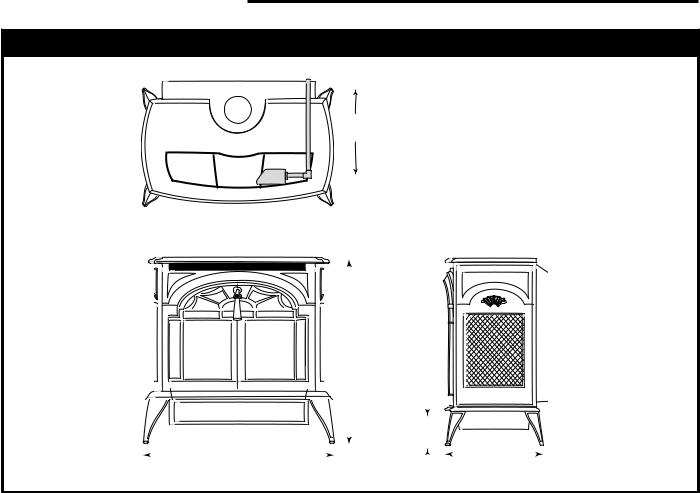
Stardance Natural Vent Gas Heater
Stardance Natural Vent Gas Heater Dimensions
25" (635 mm)
See Page 5 for Flue Collar
Centerline Dimensions.
9"
(229mm)
CL VInletalve
26 "
(680 mm)
Valve Inlet |
|
CL |
3" |
|
|
|
(76 mm) |
14 " 
(355 mm)
4406
Fig. 1 Stardance dimensions.
44 |
20007067 |
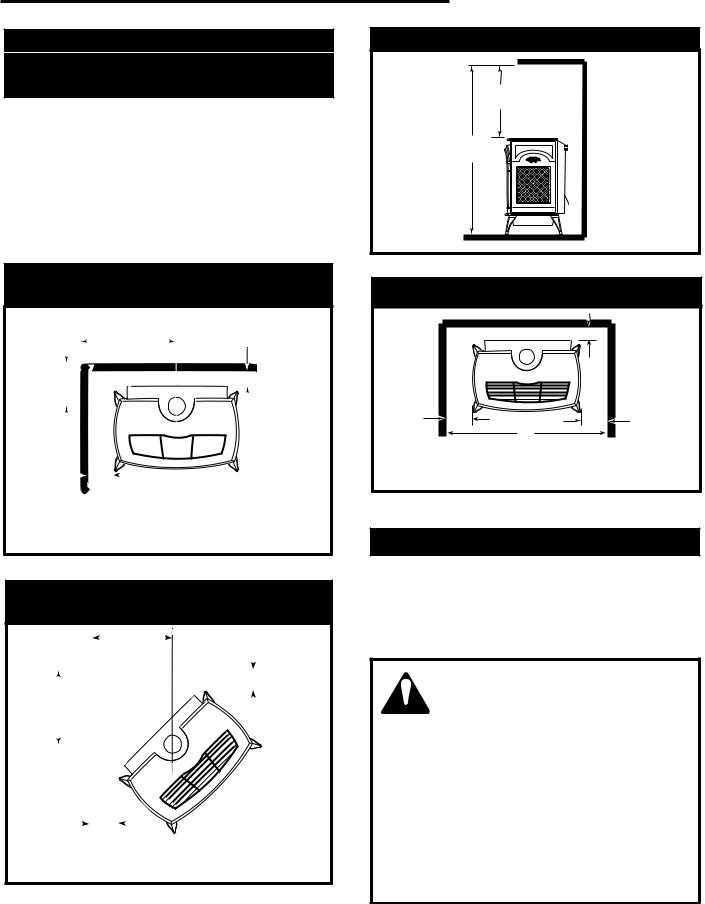
Clearance Requirements
Minimum Clearances to
Combustible Materials
Measure side clearances as shown in Figures 2 through 5 from the outer edge of the cast iron stove top. Measure rear clearances from the outermost surface of the sheet metal rear skirt.
The Stardance heater is approved for installation into an alcove constructed of combustible materials to the dimensions and clearances shown on the next page.
The same clearances apply in a standard parallel installation.
Parallel Installation: Minimum Clearance
and Flue Centerline
|
C |
|
|
L |
|
|
C |
|
D |
A |
|
C |
||
|
||
|
L |
|
|
B |
Stove Clearances |
A: 5” (125mm) |
|
|
B: 4” (102mm) |
|
Pipe Centerlines |
C: 16” (406mm) |
|
|
D: 9¹⁄” (235mm) |
ST128b |
Fig. 2 Parallel installation requirements.
Corner Installation: Minimum Clearance and
Flue Centerline
B
A
B
A |
|
|
Stove Clearance |
A: 4” (102mm) |
|
Pipe Centerline |
B: 17” (432mm) |
ST129b |
Fig. 3 Corner installation requirements.
20007067
Stardance Natural Vent Gas Heater
Ceiling Clearances
45" (1140mm)
72" |
(1829mm) |
ST657
Fig. 4 Minimum ceiling clearance; minimu alcove height.
Alcove Minimum Dimensions
C
A |
A |
B
A:4” (102mm)
B:33” (838mm)
C:5” (125mm)
ST658
Fig. 5 The Stardance Natural Vent Stove is approved for installation into alcoves built of combustible materials.
Hearth Requirements
The Stardance Heater must be installed on rigid flooring. When the heater is installed directly on any combustible surface other than wood flooring, a metal or wood panel extending the full width and depth of the unit must be used as the hearth. There are no other hearth requirements.
WARNING:
•Always maintain required clearances
 (air spaces) to nearby combustibles to prevent fire hazard. Do not fill air spaces with insulation. All venting compo-
(air spaces) to nearby combustibles to prevent fire hazard. Do not fill air spaces with insulation. All venting compo-
nents must maintain a 1” (25 mm) clearance to combustible materials. Maintain a 6” (152 mm) clearance when using single wall pipe.
•The gas appliance and vent system must be vented directly to the outside of the building and never be attached to a chimney serving a separate solid fuel or gas-burning appliance.
•Refer to the manufacturer’s instructions included with the venting system for complete installation procedures.
5
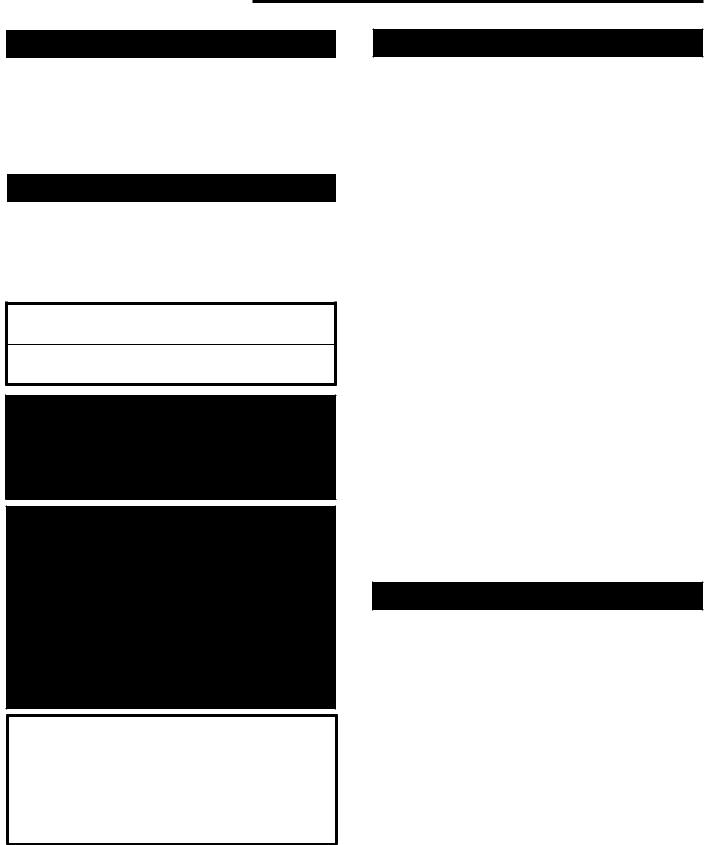
Stardance Natural Vent Gas Heater
|
Gas Specifications |
|
|||
|
|
|
|
|
|
|
|
|
|
|
|
|
|
|
|
Max. |
Min. |
|
|
|
|
Input |
Input |
Model |
Fuel |
Gas Control |
BTU/h |
BTU/h |
|
SNV30RN |
Nat |
|
Millivolt |
28,000 |
19,000 |
SNV30RP |
Prop |
|
Millivolt |
28,000 |
21,500 |
|
|
|
|
|
|
Weight: Fully assembled 350 lbs. |
|
|
|||
|
|
|
|
|
|
Gas Inlet and Manifold Pressures |
|||||
|
|
|
|
|
|
|
|
|
Natural |
LP (Propane) |
|
Inlet Minimum |
|
5.5” w.c. |
11” w.c. |
||
Inlet Maximum |
|
14” w.c. |
14” w.c. |
||
Manifold Pressure |
|
3.5” w.c. |
10” w.c. |
||
Stardance Natural Vent
Certified to:
ANSI Z21.88-2005 / CSA Z2.33-2005
Vented Gas Fireplace Heaters
The installation must conform with local codes or, in the absence of local codes, with the National Fuel Gas Code, ANSI Z223.1/NFPA 54 - latest edition. (EXCEPTION: Do not derate this appliance for altitude. Maintain the manifold pressure at 3.5” w.c. for Natural Gas and 10” w.c. for Propane.)
High Elevations
Input ratings are shown in BTU per hour and are certified without deration for elevations up to 4,500 feet (1,370m) above sea level.
For elevations above 4,500 feet (1,370m) in USA, installations must be in accordance with the current ANSI Z223.1/NFPA 54 and/or local codes having jurisdiction.
In Canada, please consult provincial and/or local authorities having jurisdiction for installations at elevations above 4,500 feet (1,370m).
WARNING: Improper installation, adjustment, alteration, service or maintenance can cause injury or property damage. Refer to this manual for correct installation and operational procedures. For assistance or additional information consult a qualified installer, service agency, or the gas supplier.
Venting Requirements and Options
The Stardance must be properly connected to a listed 4” (102 mm) Type B venting system or to an approved Class A masonry or factory-built chimney system. In Canada, a complete relining of Class A chimney systems is required.
The Stardance Natural Vent stove will accept decorative 6” (152 mm) stove pipe around the Type B venting system, for aesthetic purposes.
Complete Type B vent systems are available from a number of manufacturers, and your dealer can usually supply one. Pipe sections from different makers are not interchangeable; do not mix pipe or vent sections from different makers. Follow the vent system manufacturer’s instructions.
The vent system should conform to the specifications of the National Fuel Gas Code, latest edition.
If connecting to a Class A chimney system, use 4” (102 mm) single wall or 4” Type B vent connector. Single wall vent connector requires a minimum 6” (152 mm) clearance to combustible surfaces.
Exterior chimneys may be subject to flow reversal or condensation. To lessen these conditions, enclose Type B vents in an insulated chase, or reline exterior Class A chimneys.
An approved pass-through device is always required, whether the vent system passes through a wall or
a ceiling. Use a pass-through device from the same maker who supplies the venting system.
Venting terminals shall not be recessed into a wall or siding.
Vent Layout and Height Requirements
Venting for a Stardance can rise vertically through the home, or can pass through an exterior wall and rise along the outside of the home. Some codes require that a Type B vent system rising on the outside of the home be enclosed in a chase. Check your local codes for requirements.
The minimum vent system height for the Stardance Natural Vent Stove is 8’ (2.43 m), (Fig. 7) measured from the top of the stove. To determine the minimum height the vent system must extend through or past the roof, refer to the 1993 edition of the National Fuel Gas Code.
66 |
20007067 |
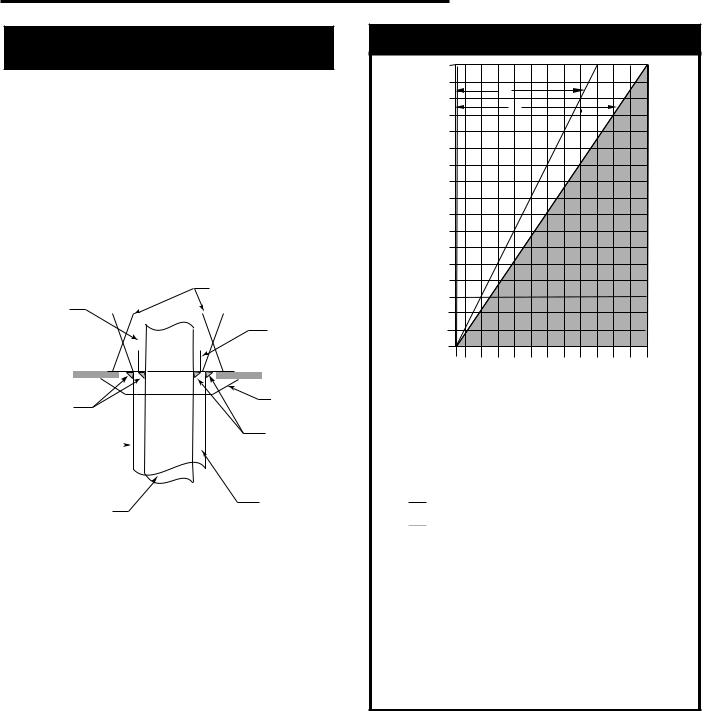
Passing Through a
Combustible Wall or Ceiling
An approved pass-through device is always required when a vent passes through a combustible wall or ceiling. Check with the maker of the vent system for the correct listed devices that are available. A listed passthrough device is required whether or not the installation includes decorative pipe around the Type B venting system. NOTE: It is essential to seal between the ceiling support (sometimes called a ‘firestop spacer’) and the decorative pipe, if installed, with a high-temperature silicone sealant. (Fig. 6)
Complete the venting system installation according to the manufacturer’s instructions.
|
Air Space as Re- |
|
Joists |
||||||||
|
quired by Code |
|
|
|
|
|
|||||
|
|
|
|
|
|
|
|
|
|
|
Ceiling |
|
|
|
|
|
|
|
|
|
|
|
|
|
|
|
|
|
|
|
|
|
|
|
Support |
|
|
|
|
|
|
|
|
|
|
|
|
|
|
|
|
|
|
|
|
|
|
||
High-tempera- |
|
|
|
|
|
||||||
ture Silicone |
|
|
|
|
Trim Col- |
||||||
Sealant |
|
|
|
|
|||||||
|
|
|
|
lar |
|||||||
|
|
|
|
|
|
|
|
|
|
|
|
|
Decorative |
|
|
|
|
High-tem- |
|||||
|
6” Pipe |
|
|
|
|
|
|
perature |
|||
|
|
|
|
|
|
|
|
|
|
|
Silicone |
|
|
|
|
|
|
|
|
|
|
|
Sealant |
|
|
Listed 4” |
|
|
|
|
|
||||
ST361 |
|
(102 mm) |
|
|
|
|
Air Space |
||||
|
B-Vent |
|
|
|
|
|
|||||
Fig. 6 A ceiling pass-through, with decorative pipe around the vent.
Stardance Natural Vent Gas Heater
Venting Requirements
|
elbow) |
36 |
|
|
|
|
|
|
|
|
34 |
|
|
A |
|
|
|
|
|
|
32 |
|
|
B |
|
|
|
||
|
30 |
|
|
|
|
|
|
||
|
any |
|
|
|
|
|
|
||
|
28 |
|
|
|
|
|
|
|
|
feet)Q |
before |
|
|
|
|
|
|
|
|
26 |
|
|
|
|
|
|
|
||
24 |
|
|
|
|
|
|
|
||
|
|
|
|
|
|
|
|
||
(in unit |
22 |
|
|
|
|
|
|
|
|
20 |
|
|
|
|
|
|
|
||
Vertical Run |
from top of the |
|
|
|
|
|
|
|
|
18 |
|
|
|
|
|
|
|
||
16 |
|
|
|
|
|
|
|
||
14 |
|
|
|
|
|
|
|
||
12 |
|
|
|
|
|
|
|
||
10 |
|
|
|
|
|
|
|
||
|
(Measured |
|
|
|
|
|
|
|
|
|
8 |
|
|
|
|
|
|
|
|
|
6 |
|
|
|
|
|
|
|
|
|
4 |
|
|
|
|
|
|
|
|
|
|
2 |
|
|
|
|
|
|
|
|
|
1 |
2 |
4 |
6 |
8 |
10 12 14 16 18 |
20 22 |
24 |
Horizontal Run (in feet)
Venting Runs
NOTE: When venting staight vertical, without an elbow, a minimum of 8 ft. vertical is required off the top of the stove.

 = Acceptable venting configuration
= Acceptable venting configuration  = Unacceptable venting configuration
= Unacceptable venting configuration
A:Vertical installations up to 36 feet (12m) in height. Up to an 18 ft. horizontal vent run can be installed within the vent system using a maximum of two 90-degree elbows or four 45-degree elbows.
B:Vertical installations up to 36 feet (12m) in height. Up to a 24 ft. horizontal vent run can be installed within the vent system using a
maximum of two 45-degree elbows. |
|
(Ratio = 2/3, Hor./Vert.) |
FP567b |
Fig. 7 Vent termination window.
20007067
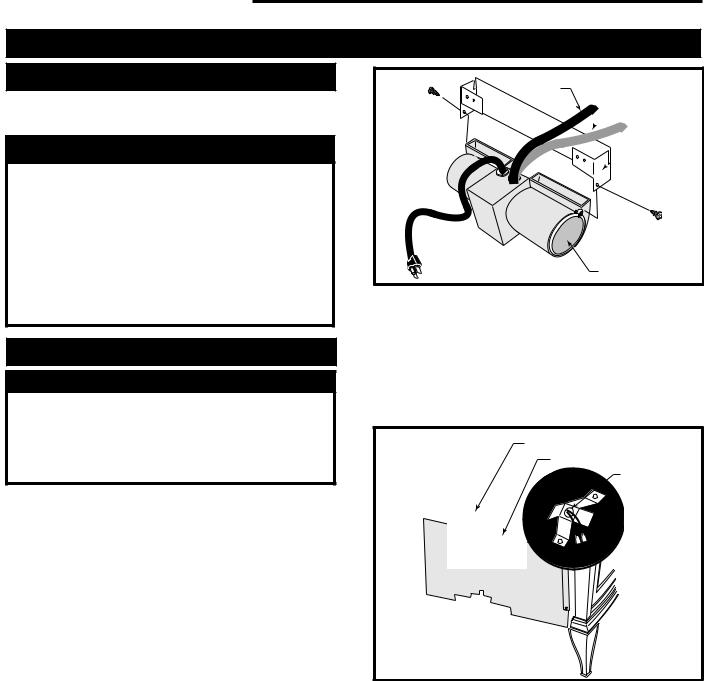
Stardance Natural Vent Gas Heater
Installation
Unpack the Stove
The Stardance is shipped fully assembled on its back. Unpack the stove and carefully set it upright.
CAUTION
Porcelain enamelled surfaces are fragile. Handle porcelain enamelled castings tenderly. Familiarize yourself with the assembly steps before you begin and proceed with deliberation and care. If possible, have assistance available.
Place enamelled castings on a soft, cushioned surface until you are ready to assemble.
Avoid contact between the castings and other hard surfaces or objects.
Install the Optional Fan
WARNING
This appliance is equipped with a three-prong (grounded) plug for your protection against shock hazard and should be plugged directly into a properly grounded three-prong receptacle. Do not cut or remove the grounding prong from this plug.
If you are installing the optional convection Fan Kit #2767 (FK26), continue here. If you are not installing a fan kit, proceed to Venting System Assembly.
1.The fan kit includes a blower assembly and a rheostat assembly, connected by a cable. The blower assembly mounts to the bottom rear of the stove, and the rheostat mounts to the left side of the valve. The assembly includes a ‘snapstat’ which automatically turns the fan ON (or OFF) above (or below) approximately 109°F. The rheostat also provides a range of fan speed settings from Off (which overrides the snapstat function) to High. Unpack and inspect the blower assembly. Confirm that the fan spins freely.
2.Remove the rear shroud by loosening the two (2) bolts at the bottom left and right side of the shroud. Slide shroud straight up, rotate the bottom out and away from stove and pull shroud out.
3.Attach the fan assembly to the fan bracket provided in the log box. Use #10 sheet metal screws provided in fan kit. Do not remove finger guard screws. (Fig.
8)
Snapstat
Wire
 Rheostat Wire
Rheostat Wire
 Fan Bracket
Fan Bracket
ST669 |
Finger Guard |
Fig. 8 Attach the fan assembly to the fan bracket.
4.Connect snapstat leads. Disconnect the snapstat module from the leads inside the snapstat bracket. (Fig. 9) Bend open the snapstat bracket. Use needle nose pliers to remove the black plastic grommet from the bracket. Discard the bracket. Connect
the two wires to the two snapstat extension leads located between the inner and outer shroud.
Snapstat Bracket
Snapstat Module
Pinch
Grommet to
Remove
ST670
Fig. 9 Remove the snapstat and grommet from the bracket
5.Position the fan assembly so the ducts slide between the inner and outer shroud. The inner shroud should engage with the two slots in the ends of the bracket so the bracket and shroud are interlocked. (Fig. 10) Secure the bracket with the four sheet metal screws provided in the finish bag.
6.Install the snapstat by loosening the front screw on the inner side of the duct. (Fig. 11) Slide the snapstat under the head of the screw and tighten. Connect the leads to the snapstat. Make sure the snapstat assembly is mounted straight front to back.
7.Reattach rear shroud assembly in reverse order of Step 2. Tighten bottom bolts to hold shroud in place.
88 |
20007067 |
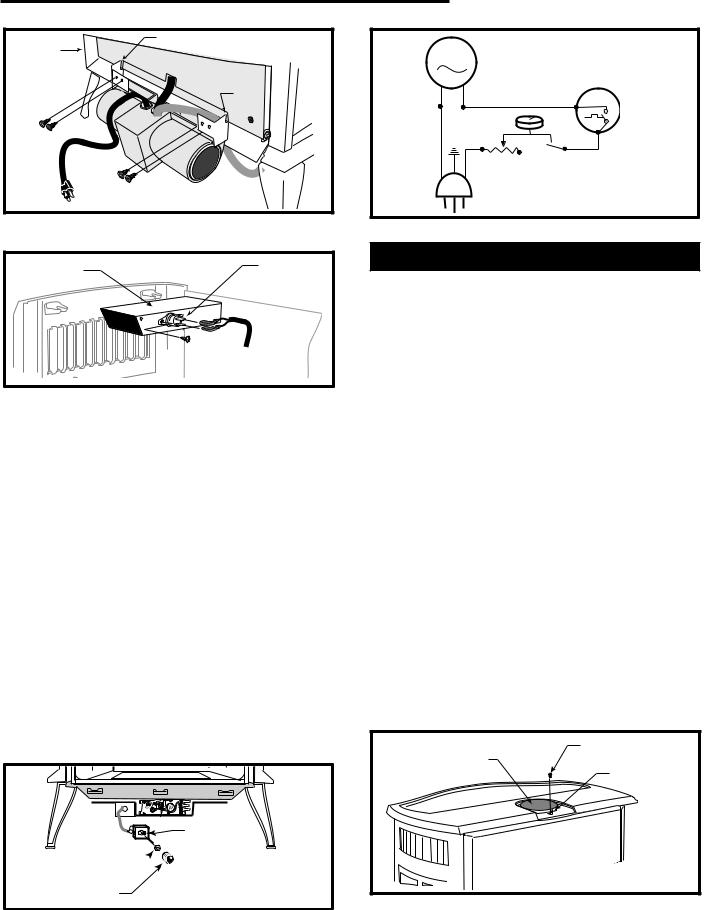
Outer |
Slot |
Shroud |
|
|
Inner Shroud |
|
Slot |
ST194 |
|
Fig. 10 Position the fan to engage the inner shroud with the fan bracket slots and secure with sheet metal screws.
Left Air Duct |
Snapstat |
|
|
|
|
|
NOTE: Shown without |
|
|
top for clarity. |
ST671 |
|
|
|
Fig. 11 Install the snapstat and connect the extension wire terminals. View is with top removed, however, access is available through the grille opening.
8.The rheostat control switch attaches to the left side of the valve bracket at the front of the stove. (Fig. 12)
•Remove retaining nut from shaft of rheostat. (if preinstalled)
•Insert the rheostat through the hole in the back of the left side of the valve bracket, aligning the locator pin with the smaller hole in that bracket.
•Thread the retaining nut onto the shaft of the rheostat, tightening with a wrench. Do not overtighten.
•Attach the control knob to the rheostat shaft.
•Use the wire tie to secure the fan and rheostat wire harnesses together.
9.Plug the power cord into a standard grounded 110 volt household outlet. If the fan control knob is not turned to the OFF position, the fan will turn on when the temperature at the snapstat reaches approximately 109°F.
Retaining Nut 
Control Knob |
ST347a |
Fig. 12 Attach rheostat to left side of valve.
20007067
Stardance Natural Vent Gas Heater
|
MOTOR |
|
|
BLK |
BLK |
BLK |
SNAPSTAT |
|
|
|
BLK |
WHT |
WHT |
GRN |
ON/OFF |
RHEOSTAT |
POWER
ST196
Fig. 13 #2767 / FK26 fan wiring diagram.
Venting System Assembly
Adjust the leg levelers as needed. They should not extend any further from the leg than necessary.
The venting collar is on the sheet metal draft hood/heat exchanger assembly, over the firebox. Use a B-vent adapter, from the same maker as the rest of the B-vent components, to join the first section of venting to the draft hood.
The SNV30 stove includes a spill switch. Operating this stove when not connected to a properly installed and maintained venting system, or tampering with or disconnecting the spill switch, can result in carbon monoxide (CO) poisoning and possible death.
The stove includes a bracket for installing decorative 6” (152mm) round stove pipe around the B-vent, for appearance purposes only. The decorative pipe need not be concentric with the vent pipe.
If the installation includes decorative stove pipe around the venting system, make a cardboard template of the decorative pipe by tracing its circumference. Put this template in the flue recess in the stove top. Position the template to fit well against the front of the recess. (Fig. 14) Use this template to locate the bracket to hold the decorative pipe. Depending on spacing, the bracket may fit inside the decorative pipe without interfering with the vent system. Fasten the bracket to the draft hood/heat exchanger assembly with a sheet metal screw.
Sheet Metal Screw
Template
Bracket
ST372
Fig. 14 Use a template to locate the bracket for decorative pipe to surround the B-vent pipe.
9
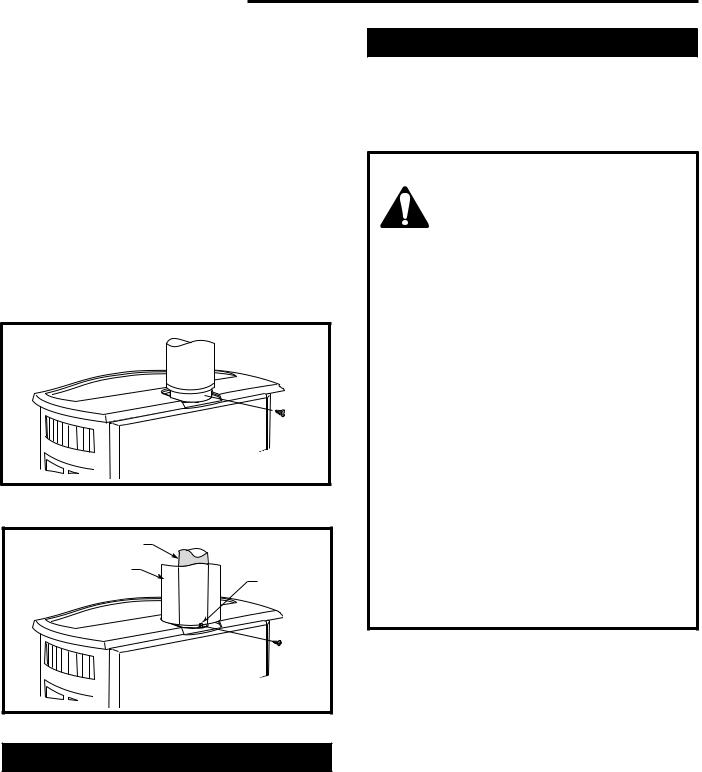
Stardance Natural Vent Gas Heater
Insert the B-vent adapter into the flue collar and drill 1/8” (3mm) pilot holes through both the stove’s collar and the adapter. Attach the adapter to the flue collar with sheet metal screws. (Fig. 15)
Attach the first section of venting to the B-vent adapter. Depending on the length of the individual venting sections and the lengths of the decorative pipe, you may need to slip the decorative pipe over the venting sections before attaching upper sections to lower ones. The sections of decorative pipe should be oriented with their seams (if any) toward the wall; sections usually do not need to be fastened at each joint, other than slip sections. The decorative pipe need not be fastened to the locating bracket on the stove. If the layout includes a slip section, this should be the last section of pipe visible in the room at the ceiling. Refer to Page 7, Figure 6
for details on joining the decorative pipe at the ceiling.
ST373
Fig. 15 Attach the B-vent adapter to the flue.
B-vent Pipe
Decorative
Pipe 7FSSK
Bracket
ST374
Fig. 16 Install decorative pipe over the B-vent pipe.
Paint Option for Enamelled Stoves
If you wish to match the decorative or vent pipe to the color of the stove, paint the pipe before installation. Use only a high-temperature paint. Paint only in a well-venti- lated area. Mask the surroundings to prevent overspray. Apply the paint lightly; two light coats will result in a better finish than a single heavy coat. Let the paint dry thoroughly before handling painted parts.
Connect the Gas Supply Line
Check the Rating Plate attached by a steel cable to the firebox, to confirm that you have the appropriate firebox for the type of fuel to be used. The Stardance may be converted from one gas to another using the appropriate Fuel Conversion Kit listed on Page 24.
CAUTION
This appliance should only be connected by a qualified gas technician. Test to confirm manifold pressures as specified
below.
The Stardance Heater and its individual shutoff valve must be disconnected from the gas supply piping during any pressure testing of that system at test pressures in excess of 1/2 psig (3.5 kPa).
The Stardance Heater must be isolated from the gas supply piping system by closing its individual manual shutoff valve during any pressure testing of the gas supply piping system at test pressure equal to or less than 1/2 psig.
There must be a gas shutoff between the stove and the supply.
In order to connect Natural Gas, use a fitting with 3/8” NPT nipple on the valve side and 1/2” natural gas supply line with an input of 28,000 BTUs at a manifold pressure of 3.5” and a minimum inlet supply pressure of 5.5” w.c.
In order to connect Propane, use a fitting with 3/8” NPT nipple on the valve side and 1/2” propane gas supply line with an input of 26,000 BTUs at a manifold pressure of 10.0” and a minimum inlet supply pressure of 11.0” w.c.
In the U.S.; Gas connection should be made in accordance with current National Fuel Gas Code, ANSI Z223.1/NFPA 54. Since some municipalities have additional local codes, be sure to consult you local authority.
In Canada; consult the local authority and CSA-B149.1 installation code.
Connect the gas supply and test for leaks. Use a 50/50 solution of liquid soap and water to test for leaks at gas fittings and joints. Apply water/soap solution with brush only - do not over apply. NEVER test with an open flame. Light the pilot according to the directions on Page 14, before going to the next step.
1010 |
20007067 |
